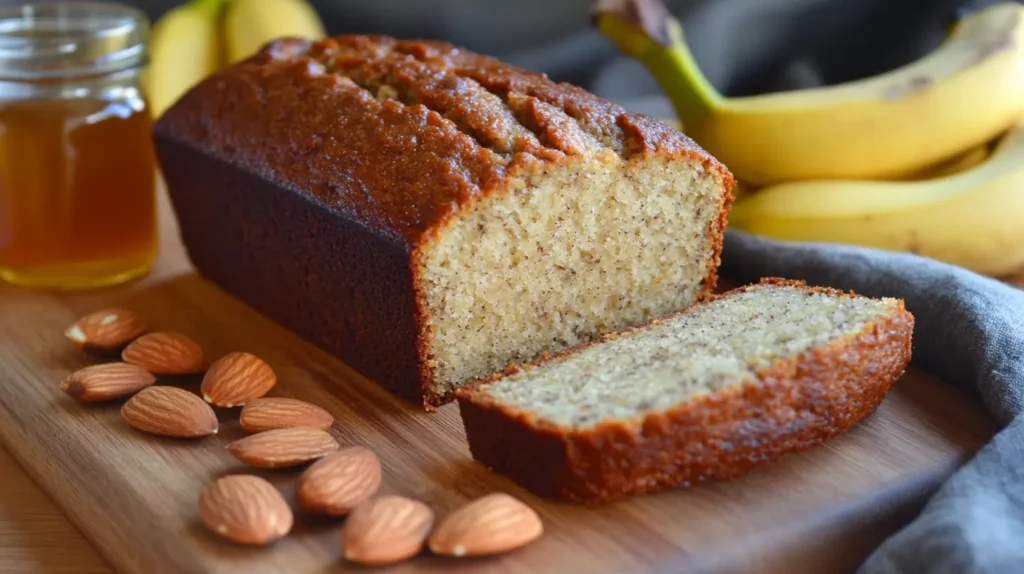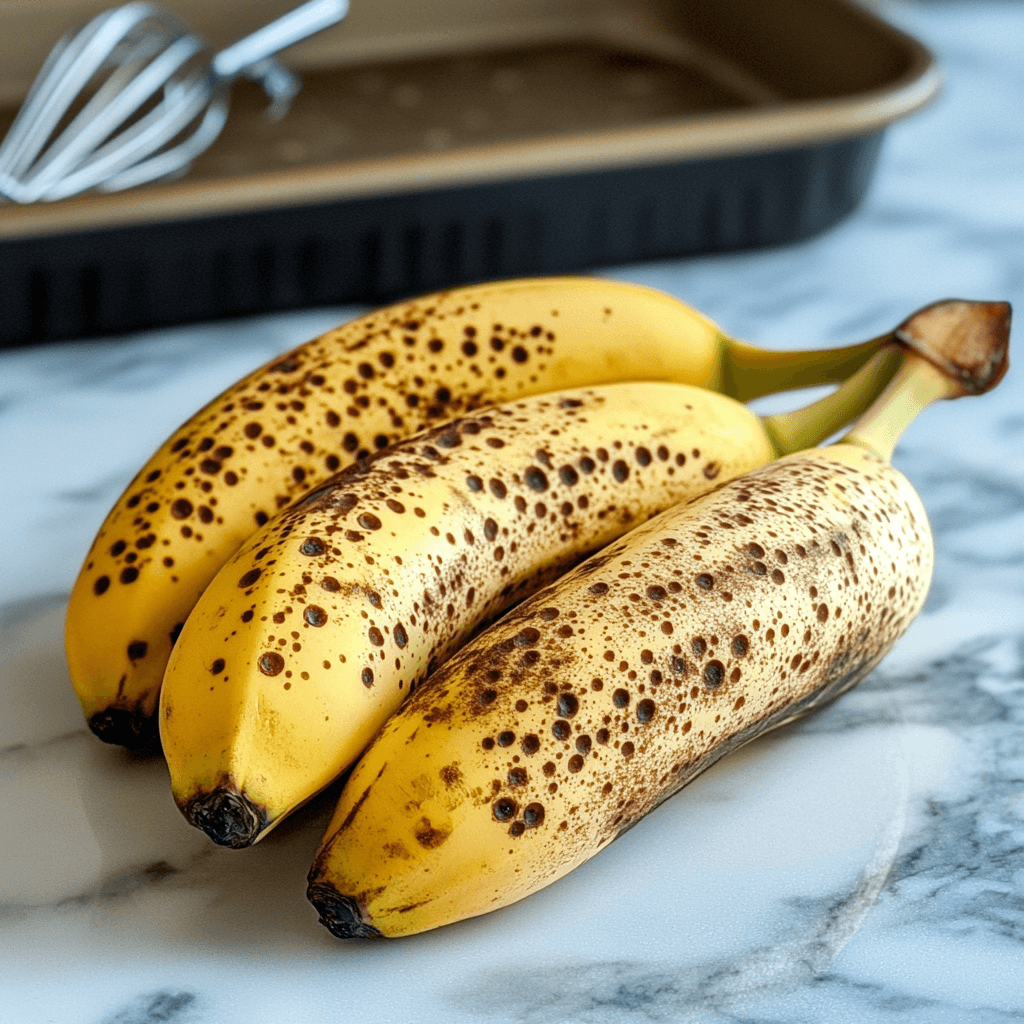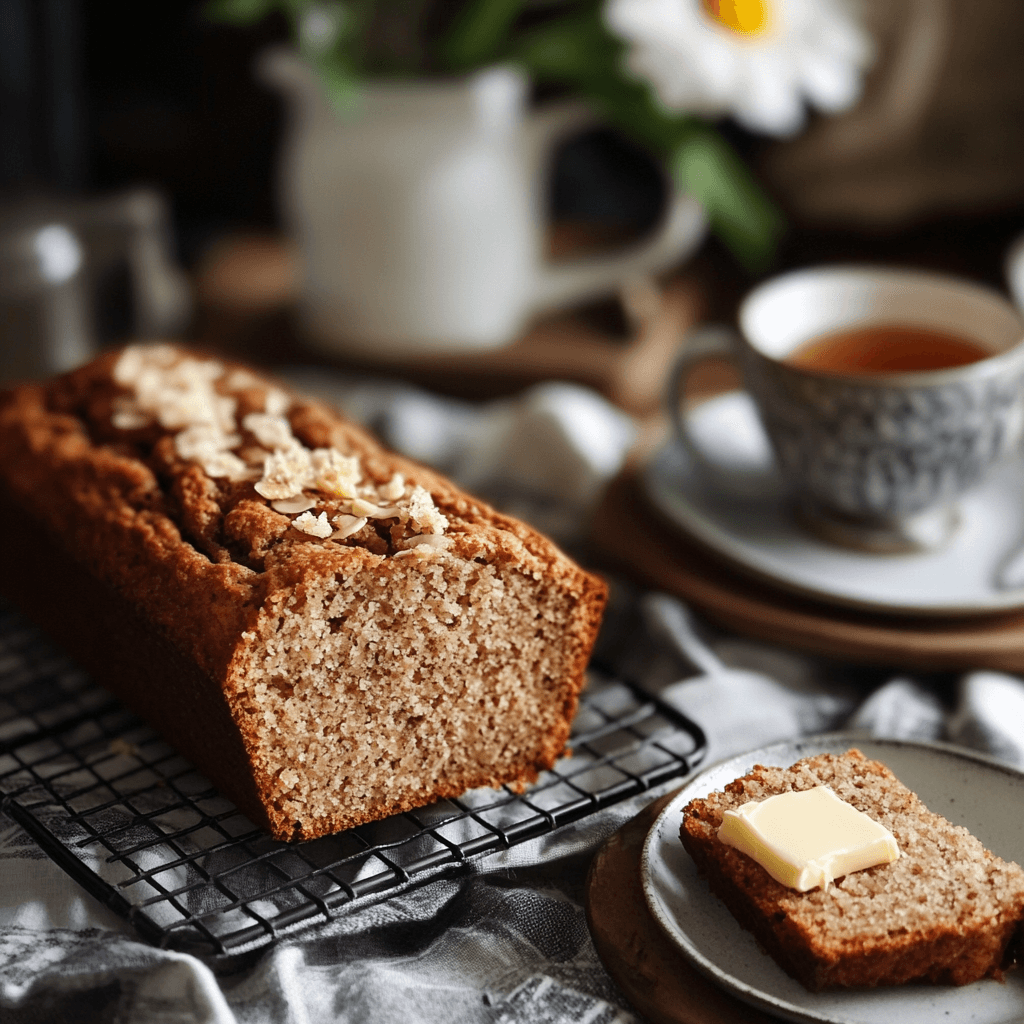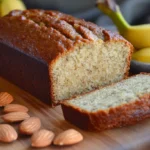Banana bread has long been a beloved comfort food, offering a sweet and satisfying way to use overripe bananas. However, traditional recipes often rely on all-purpose flour and refined sugar, which may not align with everyone’s dietary preferences or health goals. Enter almond flour banana bread—a gluten-free, nutrient-dense alternative that doesn’t compromise on flavor or texture.
Almond flour, made from finely ground blanched almonds, adds a rich nuttiness to this classic treat while providing a healthier profile. Packed with protein, healthy fats, and low in carbs, almond flour is a favorite among those following gluten-free, paleo, or keto diets. Pairing it with naturally sweet bananas creates a moist, tender bread that feels indulgent but is wholesome enough to enjoy guilt-free.

Whether you’re looking for a gluten-free option, a way to incorporate more nutritious ingredients into your baking, or simply want to try a fresh take on a classic recipe, almond flour banana bread is the perfect solution. Let’s dive into why this version is a game-changer and how you can make it at home.
Table of Contents
Why Choose Almond Flour for Banana Bread?
The Benefits of Almond Flour Over Traditional Flours
Almond flour is quickly gaining popularity in the world of baking, and for good reason. When it comes to Almond Flour Banana Bread, it offers a variety of benefits that make it a superior choice compared to traditional wheat flours. Here are some key reasons to opt for almond flour in your banana bread recipe:
1. Gluten-Free and Celiac-Friendly
Traditional flours contain gluten, which can cause digestive issues for people with gluten intolerance or celiac disease. Almond flour, made entirely from almonds, is naturally gluten-free, making it a perfect alternative for those looking to avoid gluten without sacrificing taste or texture.
2. Nutrient-Dense Profile
Almond flour is packed with nutrients, including vitamin E, magnesium, calcium, and iron. It’s also a rich source of healthy monounsaturated fats, which are good for heart health. Unlike traditional flours that are often processed and stripped of nutrients, almond flour delivers a wholesome and nutritious boost.
3. Low-Carb and Keto-Friendly
For those following a low-carb or keto diet, almond flour is a fantastic substitute for traditional flours. It contains significantly fewer carbohydrates while being higher in fiber, which helps support stable blood sugar levels and keeps you feeling full longer.
4. High in Protein
Almond flour boasts a higher protein content compared to wheat-based flours. Protein is essential for muscle repair, growth, and overall health. Adding almond flour to your Almond Flour Banana Bread means you’re sneaking in some extra protein with every slice.
5. Adds Moisture and a Rich Flavor
Unlike wheat flour, almond flour lends a naturally moist and slightly sweet, nutty flavor to baked goods. This enhances the taste and texture of Almond Flour Banana Bread, making it irresistibly tender and flavorful without the need for excessive sugar or fats.
6. Paleo and Whole30-Compatible
For those following a paleo or Whole30 lifestyle, almond flour is a go-to ingredient. It’s unprocessed, grain-free, and aligns perfectly with clean-eating principles, making it an excellent choice for creating delicious, diet-friendly Almond Flour Banana Bread.
Ingredients Needed for Almond Flour Banana Bread
The Essential Ingredients and Substitutions
To make almond flour Almond Flour Banana Bread, you’ll need a combination of staple ingredients and a few specialty items to achieve the perfect balance of flavor, texture, and nutrition. Here’s a breakdown of the essential ingredients and possible substitutions:
- Almond Flour: The star of the recipe, almond flour provides the nutty flavor and moist texture that make this Almond Flour Banana Bread special. Use finely ground almond flour for the best results, as it blends smoothly into the batter.
- Overripe Bananas: These are the key to adding natural sweetness, moisture, and depth of flavor. The riper, the better—look for bananas with brown spots for optimal sweetness.
- Eggs: Eggs act as a binder and help create a light, fluffy texture. For a vegan alternative, you can substitute eggs with flaxseed meal mixed with water (1 tablespoon flaxseed meal + 2.5 tablespoons water per egg).
- Sweetener: While bananas provide natural sweetness, you may want to add a bit more. Honey, maple syrup, coconut sugar, or a keto-friendly sweetener like erythritol can be used, depending on your dietary preferences.
- Baking Powder and Baking Soda: These leavening agents ensure your bread rises well and achieves a tender crumb.
- Vanilla Extract: Adds a warm, aromatic flavor that enhances the natural sweetness of the bananas.
- Cinnamon: A touch of cinnamon brings a cozy, spiced note that pairs beautifully with bananas.
- Salt: Just a pinch of salt balances the sweetness and enhances the overall flavor.
Optional Add-Ins:
- Chocolate Chips: For a touch of indulgence, dark chocolate chips or sugar-free chocolate chips can be added.
- Nuts: Chopped walnuts or pecans bring a crunchy contrast to the moist bread.
- Seeds: Chia seeds or flaxseeds can boost the nutritional profile.
Substitutions:
- If almond flour isn’t available, you can use hazelnut flour or a blend of coconut flour (adjusting the liquid ratio, as coconut flour absorbs more moisture).
- For a dairy-free option, swap any butter in the recipe with coconut oil or plant-based butter.
Overripe Bananas: The Secret to Moist Banana Bread

The secret to truly moist and flavorful Almond Flour Banana Bread lies in using overripe bananas. As bananas ripen, their starches convert to sugars, making them softer, sweeter, and perfect for baking. Here’s what to look for:
- Spotty Skin: Choose bananas with plenty of brown spots but avoid those that are fully black or moldy.
- Soft Texture: The flesh should be soft but not mushy or leaking liquid.
- Intense Aroma: Ripe bananas emit a strong, sweet smell, indicating they’re ready to be used.
If your bananas aren’t ripe enough, you can speed up the process by placing them in a paper bag for a day or two or baking them in the oven at 300°F (150°C) for 15-20 minutes until the skins turn black.
How to Choose the Best Almond Flour for Baking
The quality of almond flour you use can make a significant difference in your Almond Flour Banana Bread. Here’s what to consider when selecting almond flour:
- Blanched vs. Unblanched: For baking, always use blanched almond flour, which is made from almonds with their skins removed. This results in a finer, smoother texture that’s ideal for baked goods. Unblanched almond flour may create a grainy or dense loaf.
- Finely Ground: Look for almond flour labeled as “finely ground” or “superfine.” Coarse almond meal, made from ground almonds with skins, won’t provide the same light, tender texture.
- Freshness: Almond flour has a high fat content, which makes it prone to rancidity. Always check the expiration date and store it in an airtight container in the fridge or freezer to maintain freshness.
- Certified Gluten-Free: If you’re gluten-sensitive, make sure the almond flour is labeled as certified gluten-free to avoid cross-contamination during processing.
- Trusted Brands: Well-known brands like Bob’s Red Mill, Blue Diamond, or King Arthur often provide high-quality almond flour that’s reliable for baking.
Choosing the right almond flour ensures your banana bread turns out moist, fluffy, and delicious every time. With these ingredients and tips, you’re set to bake a healthy and irresistible loaf!
Step-by-Step Guide to Baking Almond Flour Banana Bread
Preparation Steps to Ensure Perfect Results Every Time
To create a perfectly moist and flavorful almond flour banana bread, it’s crucial to follow a structured process. From preparing the ingredients to baking the loaf, each step contributes to achieving that golden, tender result. Here’s a detailed guide:
1. Preparing the Bananas and Other Ingredients
Proper preparation is the foundation of a successful banana bread recipe.
- Mash the Bananas: Peel the overripe bananas and place them in a large mixing bowl. Use a fork or potato masher to mash them until smooth but slightly chunky. This ensures an even distribution of banana flavor and moisture throughout the bread.
- Measure the Ingredients: Precise measurements are key, especially with almond flour, as its texture can vary. Use measuring cups or a kitchen scale for accuracy.
- Preheat the Oven: Set your oven to 350°F (175°C) and position the rack in the center. This allows the bread to bake evenly.
- Prepare the Pan: Line a standard loaf pan with parchment paper or grease it lightly with oil or butter. Parchment paper makes it easier to lift the bread out after baking.
- Gather Tools: Have your mixing bowls, whisk, spatula, and measuring tools ready to streamline the process.
2. Mixing the Dry and Wet Ingredients Correctly
The technique for combining ingredients can significantly impact the texture of your banana bread.
- Combine the Dry Ingredients: In a medium-sized bowl, whisk together almond flour, baking powder, baking soda, salt, and any spices like cinnamon. This ensures the leavening agents are evenly distributed for a consistent rise.
- Mix the Wet Ingredients: In the bowl with mashed bananas, add eggs (or egg substitutes), sweetener, vanilla extract, and melted butter or oil. Use a whisk to blend until the mixture is smooth and well combined.
- Gradually Incorporate Dry into Wet: Slowly add the dry ingredients to the wet mixture in batches, stirring gently with a spatula. Avoid overmixing, as almond flour is delicate and can result in a dense loaf if overworked. Mix until just combined.
3. How to Pour and Bake for the Perfect Rise
Once the batter is ready, it’s time to bake your banana bread to perfection.
- Pour the Batter into the Pan: Transfer the batter into the prepared loaf pan, spreading it evenly with a spatula. Tap the pan lightly on the counter to release any air bubbles.
- Add Toppings (Optional): For added flavor and texture, sprinkle chopped nuts, chocolate chips, or seeds on top before baking.
- Bake: Place the pan in the preheated oven and bake for 50-60 minutes, or until the top is golden brown and a toothpick inserted into the center comes out clean. Baking times may vary slightly depending on your oven.
- Cool the Bread: Once baked, remove the pan from the oven and let it cool for 10-15 minutes. Then, lift the bread out using the parchment paper or carefully invert the pan to release it. Allow the bread to cool completely on a wire rack before slicing.
Pro Tips for Success:
- Room-Temperature Ingredients: Use room-temperature eggs and butter for a smoother batter.
- Check Mid-Bake: If the top browns too quickly, tent it with aluminum foil to prevent burning.
- Store Properly: Once cooled, store the bread in an airtight container at room temperature for up to 3 days or in the refrigerator for up to a week.
Following these steps ensures your almond flour banana bread rises beautifully, retains its moisture, and delivers that irresistible combination of flavor and texture every time.
Baking Tips and Tricks for Perfect Almond Flour Banana Bread

Ensuring Even Cooking and Avoiding Common Mistakes
Baking with almond flour can be slightly different from traditional baking, but with a few key tips and tricks, you’ll consistently achieve delicious, perfectly baked banana bread. Here’s how to ensure even cooking and avoid common pitfalls:
1. How to Tell When Your Banana Bread is Fully Baked
Knowing when your banana bread is done is crucial to avoid a soggy or overly dry loaf. Here’s how to ensure it’s fully baked:
- Look for a Golden Top: The bread should have a golden-brown crust that looks firm and slightly domed. If it’s pale, it likely needs more time.
- Toothpick Test: Insert a toothpick or skewer into the center of the bread. If it comes out clean or with a few moist crumbs, the bread is done. If wet batter sticks to it, continue baking and test again in 5-minute increments.
- Springy Touch: Gently press the top of the bread with your finger. It should feel springy and bounce back slightly, indicating it’s cooked through.
- Internal Temperature: For the most accurate test, use a food thermometer. The internal temperature of fully baked banana bread should reach 200–205°F (93–96°C).
2. Adjusting Bake Times for Different Oven Types
Different ovens may bake at slightly different rates due to variations in heat distribution. Here’s how to adjust for your oven type:
- Conventional Oven: If using a standard oven, stick to the recipe’s suggested baking time but begin checking for doneness about 5 minutes early to avoid overbaking.
- Convection Oven: Convection ovens circulate hot air, cooking faster and more evenly. Reduce the baking temperature by 25°F (about 15°C) and check for doneness 5–10 minutes earlier than the recommended time.
- Gas Oven: Gas ovens may have uneven heat distribution. To avoid hot spots, rotate the pan halfway through baking.
- Small or Countertop Oven: These ovens tend to heat more intensely due to their compact size. Lower the temperature slightly and keep a close eye on the bread as it bakes.
Pro Tips for Adjusting Bake Times:
- Altitude Adjustments: At higher altitudes, reduce baking powder slightly and increase baking time by a few minutes to prevent sinking in the center.
- Loaf Pan Size: If using a smaller or larger loaf pan, adjust the baking time accordingly. Smaller pans may cook faster, while larger pans may need extra time.
- Multiple Loaves: If baking two loaves at once, increase the baking time slightly and space the pans evenly in the oven to ensure proper airflow.
Frequently Asked Questions (FAQs)
Common Queries About Almond Flour Banana Bread
1. Can I Substitute Almond Flour with Other Flours?
Yes, you can substitute almond flour with other flours, but adjustments are necessary as almond flour behaves differently in recipes due to its high fat content and lack of gluten.
- Coconut Flour: This is a common substitute but is highly absorbent. If using coconut flour, reduce the amount to about ¼–⅓ of the almond flour called for in the recipe and increase the eggs or liquid to maintain moisture.
- Oat Flour: Oat flour can work as a replacement, but the texture will be denser, and you may need to adjust the liquid content slightly.
- All-Purpose or Whole Wheat Flour: If you’re not gluten-free, you can use these flours. However, the recipe will require more liquid or fat, as almond flour naturally contains more moisture.
For the best results, it’s recommended to stick with almond flour to achieve the moist, tender texture that defines this banana bread.
2. How Long Can I Store Almond Flour Banana Bread?
Almond flour banana bread can be stored for varying durations depending on how it’s stored:
- At Room Temperature: Store in an airtight container for up to 3 days. Keep it in a cool, dry place to prevent spoilage.
- In the Refrigerator: Banana bread stays fresh for up to 7 days when refrigerated. Wrap it tightly in plastic wrap or store it in an airtight container to retain moisture.
- In the Freezer: To extend its shelf life, freeze the bread. Slice it into individual portions, wrap each slice in plastic wrap, and place them in a freezer-safe bag or container. It can be frozen for up to 3 months. Thaw slices in the refrigerator or microwave as needed.
3. Can I Make This Banana Bread in a Muffin Pan Instead of a Loaf Pan?
Yes, you can bake the batter in a muffin pan to create banana bread muffins. Here’s how:
- Prepare the Pan: Line the muffin tin with paper liners or grease it lightly with oil.
- Adjust Baking Time: Muffins bake faster than a loaf. Check for doneness after 20–25 minutes by inserting a toothpick into the center of a muffin.
- Portion the Batter: Fill each muffin cup about ⅔ full to allow room for rising.
This is a great option if you want single-serving portions or need a quicker baking alternative.
4. Is This Recipe Keto-Friendly?
Yes, almond flour banana bread can be keto-friendly with a few modifications:
- Reduce or Eliminate Sweetener: Ripe bananas add natural sweetness, so you may not need additional sweetener. If desired, use a keto-friendly sweetener like erythritol or stevia.
- Use Minimal Bananas: Bananas are higher in carbs, so use 1–2 bananas instead of 3 to lower the carb count.
- Incorporate Keto Add-Ins: Add sugar-free chocolate chips, nuts, or seeds to boost the fat content and make the bread more keto-compliant.
Conclusion
Almond flour banana bread is more than just a healthy twist on a classic recipe—it’s a flavorful, nutrient-packed alternative that caters to a variety of dietary needs and preferences. Whether you’re seeking a gluten-free, low-carb option or simply want a moist, tender bread with a unique nutty flavor, this recipe is a fantastic choice.
The combination of overripe bananas and almond flour creates a naturally sweet, satisfying treat that feels indulgent yet wholesome. With the step-by-step guide, tips for perfect baking, and answers to common questions, you’re well-equipped to bake a loaf that’s as delicious as it is nutritious.
So, grab your ripe bananas, stock up on almond flour, and get ready to enjoy a loaf of banana bread that’s perfect for breakfast, a snack, or dessert. It’s a recipe you’ll come back to time and time again—because great taste and good health are a winning combination!
Print
almond flour banana bread
- Total Time: 1 hour
- Yield: 1 loaf (10 slices) 1x
- Diet: Gluten Free
Description
This Almond Flour Banana Bread is soft, moist, and naturally gluten-free, making it a healthy and delicious option for breakfast or a snack. It’s lightly sweetened with ripe bananas and a touch of maple syrup, with a rich nutty flavor from almond flour. Plus, it’s grain-free, dairy-free, and paleo-friendly!
Ingredients
Wet Ingredients:
- 3 large ripe bananas, mashed
- 3 large eggs (or flax eggs for vegan: 3 tbsp flaxseed meal + 9 tbsp water)
- ¼ cup maple syrup (or honey)
- 1 tsp vanilla extract
- ¼ cup coconut oil, melted
Instructions
- Preheat & Prepare – Preheat the oven to 350°F (175°C). Line a 9×5-inch loaf pan with parchment paper or grease it lightly.
- Mash Bananas – In a large bowl, mash the bananas until smooth.
- Mix Wet Ingredients – Add eggs, maple syrup, vanilla extract, and melted coconut oil. Stir until well combined.
- Combine Dry Ingredients – In another bowl, whisk together almond flour, baking soda, cinnamon, and salt.
- Mix the Batter – Gradually fold the dry ingredients into the wet ingredients, stirring until just combined. Avoid overmixing.
- Add Extras (Optional) – Gently fold in nuts or chocolate chips if using.
- Bake – Pour the batter into the prepared loaf pan and smooth the top. Bake for 45-50 minutes, or until a toothpick inserted in the center comes out clean.
- Cool & Serve – Let the banana bread cool in the pan for 10 minutes, then transfer to a wire rack to cool completely before slicing.
Notes
- Store in an airtight container at room temperature for 2 days, in the fridge for 5 days, or freeze for up to 3 months.
- Use extra-ripe bananas for natural sweetness.
- If using flax eggs, the texture will be slightly denser but still delicious!
- Prep Time: 10 minutes
- Cook Time: 45-50 minutes
- Method: Baking
- Cuisine: American
